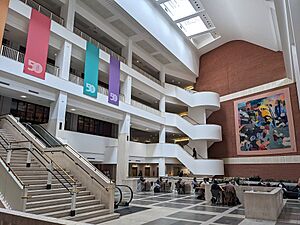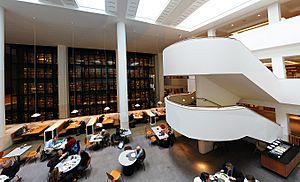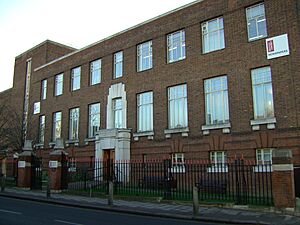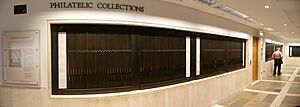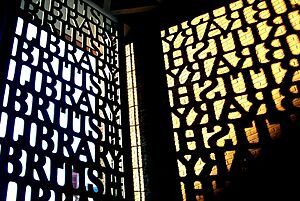British Library facts for kids
Quick facts for kids British Library |
|
|---|---|
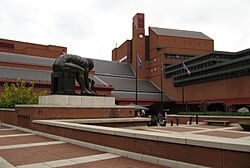 |
|
| The British Library from the piazza | |
| Country | England |
| Type | National library |
| Established | 1 July 1973 |
| Location | 96 Euston Road London, NW1 2DB |
| Coordinates | 51°31′46″N 0°07′37″W / 51.52944°N 0.12694°W |
| Branches | 1 (Boston Spa, West Yorkshire) |
| Collection | |
| Items collected | Books, journals, newspapers, magazines, sound and music recordings, patents, databases, maps, stamps, prints, drawings and manuscripts |
| Size | 200 million+ items:
|
| Legal deposit | Yes, provided in law by:
|
| Access and use | |
| Access requirements | Open to anyone with a need to use the collections and services |
| Other information | |
| Budget | £142 million |
The British Library is the national library of the United Kingdom. Located in London, it is the largest library in the world. It holds over 200 million items from many countries.
As a legal deposit library, it gets a copy of almost every book published in the UK and Ireland. It also receives many books from other countries that are sold in the UK. The library is a public body supported by the government.
The British Library is a major research library. It has items in many languages and different forms. These include books, handwritten documents, journals, newspapers, and sound recordings. It also has videos, patents, maps, and stamps. The library's collections include about 14 million books. Some items are as old as 2000 BC. The library adds about three million new items each year. These items need about 9.6 kilometers (6 miles) of new shelf space.
The library's main building is next to St Pancras station in London. Queen Elizabeth II officially opened it on 25 June 1998. It is a Grade I listed building, which means it is very important for its architecture and history. The library also has a second storage site near Boston Spa in Yorkshire.
Contents
History of the British Library
How the Library Started (1972–1997)
The British Library began on 1 July 1973. It was created by the British Library Act 1972. Before this, the national library was part of the British Museum. Most of the new library's items came from the British Museum. Other smaller groups also joined, like the National Central Library.
In 1983, the library took in the National Sound Archive. This archive holds many sound and video recordings. It has over a million discs and thousands of tapes.
The oldest parts of the library's collections came from gifts and purchases in the 1700s. These are called "foundation collections." They include books and manuscripts from Sir Hans Sloane. His decision to give his collection to the nation helped create the British Museum. The museum also bought the Harleian Library collection. The Cotton library was another important early collection. These were later joined by the Old Royal Library and the King's Library from King George III.
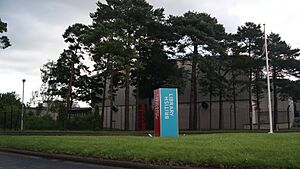
For many years, the library's collections were spread out. They were in different buildings around central London. There was also a lending center at Boston Spa in West Yorkshire. The newspaper library was in Colindale, north-west London.
Moving to St Pancras (1997–Present)
Early plans for the British Library involved tearing down part of Bloomsbury. This was so the library could be right across from the British Museum. But after a big campaign, this plan changed. The library was built instead at Euston Road. It is next to St Pancras railway station.
The library started moving its items to the St Pancras building in 1997. The first new reading rooms opened that year. From 1997 to 2009, the main collection was in this new building. The collection of newspapers was still in Colindale.
In 2008, the library announced a plan to move less-used items. These items went to a new storage building in Boston Spa. The newspaper library at Colindale closed in 2013. Its collection was split between St Pancras and Boston Spa. From 2009 to 2012, over 200 kilometers (124 miles) of material moved to the new storage. These items can be delivered to London reading rooms daily.
The new library building was designed by architect Colin St John Wilson. He worked with his wife MJ Long. The building faces Euston Road and has a large open area. This area has public art, like sculptures by Eduardo Paolozzi and Antony Gormley. It was the largest public building built in the UK in the 20th century.

In the middle of the building is a six-story glass tower. It holds the King's Library. This collection has 65,000 printed books and other items. King George III collected them between 1763 and 1820. In 2009, a new storage building opened at Boston Spa. This facility cost £26 million. It can hold seven million items. Robots help retrieve items from 162.7 miles of special storage space.
The Euston Road building became a Grade I listed building in 2015. The British Library also plans to open a third location in Leeds.
Digital Collections and Online Access
In 2005, the British Library started the UK Web Archive project. This project collects and saves websites from the UK. The library asked website owners for permission to archive their sites.
In 2013, a new law allowed the library to automatically collect all UK websites. This helps save the nation's "digital memory." The library made this material available to the public by the end of 2013. It works to make sure these digital items are saved for the future.
The library has four storage locations for digital data. These are in London, Boston Spa, Aberystwyth, and Edinburgh. They are linked by a secure network. This network automatically copies and checks data. Since 2013, the library has added a full copy of every .uk website each year.
Cyber Attack in 2023
On 28 October 2023, the British Library's website went offline. This was due to a ransomware attack. A group called Rhysida was responsible. The attack affected the library's catalogues and ordering systems. This made most of the library's collections hard to access.
The library announced that services would be disrupted for weeks, and some problems might last for months. By October 2024, many services were back online. These included remote item ordering and online learning.
Future Plans
In March 2025, the British Library announced plans for a big expansion. This project will add more public spaces to the library. It will create 100,000 square feet for cultural, learning, and research activities. This expansion is part of a £1.1 billion project.
Library Collections
The British Library is a legal deposit library. This means it has a legal right to receive a free copy of every item published in Britain. This rule dates back to at least 1610. The Copyright Act 1911 made this principle official.
The British Library is the only one that automatically gets a copy of every item. Other libraries, like the Bodleian Library at Oxford and the University Library at Cambridge, must ask for items.
Under Irish law, the British Library also gets a free copy of every book published in Ireland. This is similar to how it works in the UK.
The Legal Deposit Libraries Act 2003 added electronic items to this rule. This includes things like CD-ROMs and certain websites.
The British Library Document Supply Service (BLDSS) is based at Boston Spa. This site holds about 70% of the library's total material. This includes less-used items and the newspaper collection. The library also has the Asia, Pacific and Africa Collections (APAC). These include items from India and other parts of Asia and Africa.
Manuscripts and Old Documents
Main Collections
The library's first manuscript collections came together in 1753. These are:
- Cotton manuscripts
- Harley manuscripts
- Sloane manuscripts
Other Important Collections
Other special collections of manuscripts include:
- Arundel Manuscripts
- Egerton manuscripts
- King's manuscripts
- Lansdowne manuscripts
- Royal manuscripts
- Stefan Zweig Collection
- Stowe manuscripts
- Yates Thompson manuscripts
Additional Manuscripts
The Additional Manuscripts series includes all other manuscripts. These are items given, bought, or left to the library since 1756. The numbering starts at 4101. This is because it continued the Sloane manuscripts collection, which went from 1 to 4100.
Newspapers
The library has almost all British and Irish newspapers since 1840. This is thanks to the legal deposit law of 1869. This law required newspapers to send a copy of each edition to the library. London editions of national newspapers are complete back to 1801.
In total, the collection has 660,000 bound volumes and 370,000 reels of microfilm. This includes tens of millions of newspapers. They cover 52,000 different titles on 45 kilometers (28 miles) of shelves. Older collections include the Thomason Tracts from the 1600s. The Burney Collection has nearly 1 million pages from the late 1700s and early 1800s. The library also has many non-British newspapers in different languages.
The newspaper section was in Colindale until 2013. The buildings there were old and not good for storage. The physical newspapers are now in St Pancras and Boston Spa. St Pancras has high-use and rare items. Boston Spa holds most of the collection in a new building.
Many newspapers are now available online or on microfilm. In 2010, a ten-year project began to digitize the newspaper archives. The British Newspaper Archive launched in 2011. A special newspaper reading room opened at St Pancras in 2014. Here, you can look at microfilmed and digital newspapers. You can also request hard copies from Boston Spa.
Online and Digital Resources
The British Library has many images from its collections available online. Its Online Gallery has 30,000 images from medieval books. It also has special exhibition items, like the Lindisfarne Gospels. You can even "turn the virtual pages" of some documents, like Leonardo da Vinci's notebooks.
The library's commercial service, Secure Electronic Delivery, started in 2003. It offers over 100 million items to researchers worldwide. These items were once hard to access due to copyright rules. The library charges a fee for this service.
The British Library worked with Microsoft to digitize many books for the Live Search Books project. These books are now available through the British Library catalogue or Amazon.
In 2010, the library launched its Management and Business Studies portal. This website gives digital access to research reports and articles.
In 2011, four million newspaper pages from the 1700s and 1800s became available online. This was part of the British Newspaper Archive project. The project plans to scan up to 40 million pages over 10 years. Searching the archive is free, but there is a charge to view the pages.
As of 2022, Explore the British Library is the main online catalogue. It has almost 57 million records. You can use it to search for items and order them. The library's electronic collections include over 40,000 e-journals and 800 databases. Some of these can be accessed remotely by registered users.
PhD theses are available through the E-Theses Online Service (EThOS).
Philatelic Collections (Stamps)
The British Library Philatelic Collections are at St Pancras. These collections started in 1891 with a gift of the Tapling collection. They have grown to include over 25 major collections. These collections cover many types of stamps and related items. This includes revenue stamps, postal stationery, and covers.
About 80,000 items are on display in 1,000 frames. The Tapling Collection makes up 2,400 of these display sheets. All other items are available for students and researchers.
Library Facilities
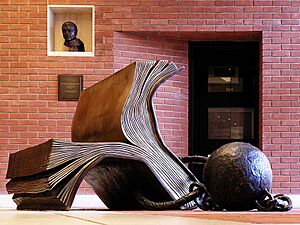
Sitting on History, with its ball and chain, refers to the book as the captor of information which we cannot escape.
The bust visible top left is Colin St. John Wilson RA by Celia Scott, 1998 a gift from the American Trust for the British Library. Sir Colin designed the British Library building.
The library is open to anyone who needs to use its collections. If you have a permanent address and want to do research, you can apply for a Reader Pass. You need to show proof of your signature and address.
In the past, only people needing special materials not found elsewhere could get a pass. The library has been criticized for letting too many university students use the reading rooms. The library says it has always allowed students if they have a real research need.
Most items can be found on "Explore the British Library," the main online catalogue. Other collections have their own catalogues. There are eleven reading rooms in London and one in Yorkshire.
Reader Pass holders can also use the Document Supply Collection. This is in the Reading Room at Boston Spa. You can also access hard-copy newspapers there. To use the Boston Spa Reading Room, you need to register as a Reader.
Exhibitions and Displays
Many books and manuscripts are on public display. You can see them in the Sir John Ritblat Gallery. It is open seven days a week and is free. Some famous items on display include Beowulf, the Lindisfarne Gospels, and a Gutenberg Bible. You can also see Geoffrey Chaucer's Canterbury Tales and Thomas Malory's Le Morte d'Arthur (about King Arthur).
Other items include Captain Cook's journal, Jane Austen's History of England, and Charlotte Brontë's Jane Eyre. You can also see Lewis Carroll's Alice's Adventures Under Ground and Rudyard Kipling's Just So Stories. There are also Charles Dickens's Nicholas Nickleby, Virginia Woolf's Mrs Dalloway, and a room just for Magna Carta. Several Qur'ans and Asian items are also on display.
Besides the permanent display, the library often has special exhibitions. These have covered maps, sacred texts, and the history of the English language. There was also a celebration for the 800th anniversary of Magna Carta.
Services and Departments
Business and IP Centre
In 2005, the British Library received money to turn two reading rooms into the Business & IP Centre. It opened in March 2006. This center has a large collection of business and intellectual property (IP) materials. It is part of a national network of Business and IP Centres in the UK.
The collection covers four main areas: market research, company information, trade directories, and journals. It is free to use in print and online through many databases. Registered readers can access these resources. Staff are there to help small businesses and entrepreneurs use the materials.
The center has over 50 million patent documents from 40 countries. These date back to 1855. The collection also includes information on trade marks and copyright. This is available in print and online.
In 2018, the Human Lending Library service started here. It lets social entrepreneurs get an hour of advice from a business expert.
Document Supply Service
When the British Library was created in 1973, it took over the National Lending Library for Science and Technology (NLL). The NLL was based near Boston Spa in Yorkshire. It had started in 1961. The site was once a factory during World War II.
The NLL became the British Library Lending Division in 1973. Later, it was renamed the British Library Document Supply Service (BLDSS).
BLDSS now holds 87.5 million items. This includes 296,000 international journal titles. It also has 3 million books, 5 million official publications, and 500,000 theses. About 12.5 million articles in the Document Supply Collection are electronic. They can be downloaded right away.
This collection helps with research and development in the UK and other countries. It is especially useful for the pharmaceutical industry. BLDSS also provides materials to universities, students, and the public. People can order items through their public library or the BLDSS service.
In 2013, BLDSS launched a new online ordering system. Customers can now search for items, see prices, and track their orders online.
Sound Archive
The British Library Sound Archive has over a million discs and 185,000 tapes. The collections come from all over the world. They cover all kinds of recorded sound. This includes music, drama, literature, oral history, and wildlife sounds. Some recordings are over 100 years old.
You can listen to recordings from the collection in certain reading rooms. This is done through their SoundServer and Listening and Viewing Service.
In 2006, the library launched British Library Sounds. This online resource makes 50,000 of the Sound Archive's recordings available online.
Moving Image Services
The British Library's moving image services started in 2012. They offer access to nearly a million sound and moving image items. These services can only be used from terminals in the reading rooms at St Pancras or Boston Spa.
The three services are:
- BBC Pilot/Redux: This project worked with BBC Research & Development. It recorded BBC's national and some regional broadcasts 24/7 since June 2007. BBC Pilot includes 2.2 million records and 225,000 playable programs. BBC Redux stopped operating in 2022.
- Broadcast News: Since May 2010, the library has recorded daily TV and radio news broadcasts. This includes news from seventeen channels like BBC, ITV, and Sky News. Many programs have subtitles that can be searched. This makes the collection very useful for research.
- Television & Radio Index for Learning & Teaching (TRILT): This is a database of all UK TV and radio broadcasts since 2001. It has 16 million records and grows by a million each year. It covers every channel, broadcast, and repeat.
Other Projects
The British Library supports many important projects. These include:
- International Dunhuang Project
- Theatre Archive Project
- Incunabula Short Title Catalogue
- DataCite, an international group that helps improve how data is cited.
- Endangered Archives Programme
Library Leaders
Chief Executives
- 1973–1984: Sir Harry Hookway, first Chief Executive
- 1984–1991: Kenneth Cooper
- 1991–2000: Dr Brian Lang
- 2000–2012: Dame Lynne Brindley
- 2012–2025: Sir Roly Keating
- From 2025: Rebecca Lawrence
Chief Librarians
- 2016–2018: Caroline Brazier, first Chief Librarian
- 2018–present: Liz Jolly
See also
 In Spanish: British Library para niños
In Spanish: British Library para niños
- British Library of Political and Economic Science, the main library of the LSE
- British literature
- Books in the United Kingdom
- The National Archives (United Kingdom), a collection of important government records


